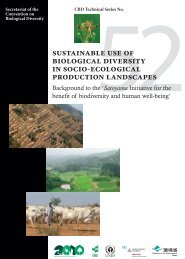INDIAN SCIENCE CONGRESS - India Environment Portal
INDIAN SCIENCE CONGRESS - India Environment Portal
INDIAN SCIENCE CONGRESS - India Environment Portal
Create successful ePaper yourself
Turn your PDF publications into a flip-book with our unique Google optimized e-Paper software.
20<br />
Proc. 98th <strong>India</strong>n Science Congress, Part II : Presidential Address<br />
K. G. Mukerji, Prof. Ajit Verma, Prof. KVVR Tilak, Dr. Alok Adoleya and few<br />
others gathered to discuss the plans for bringing together scientists working on<br />
mycorhhiza with TERI, New Delhi as the coordinating Institution. A conference on<br />
mycorrhiza was organized at JNU in the first instance, followed by another at CAS<br />
in Botany, Madras and still another at Chang Mai, Thaliland with in a span of almost<br />
5 years. Prof. Fortin from Canada and Prof. James Trappe from USA were<br />
associated at one or the other time Dr. D J Bhagyaraj from Bangalore and C.<br />
Manoharachary from Hyderabad along with Drs Mukerji, Mahadevan, Naatraj, Ajit<br />
Verma, K. V. V. R Tilak helped in framing the guidelines for mycorrzial research<br />
in <strong>India</strong>. I was also an active participant in all these deliberations.<br />
These efforts helped in identifying groups as well as in generating interest in<br />
others in mycorrhizal research. IDRC Canada provided some funding and training<br />
Centers in ectomycorrhial research were established at CAS in Botany, Madras<br />
University, Deptt. of Biosciences, H. P. University, Shimla, and TERI at New<br />
Delhi. Deptt. of Biosciences at NEHU also became actively involved in<br />
ectomycorrhizal research. Since then, these institutions have carried out work on<br />
the mycorrhiza of important conifer species of their respective regions.<br />
The research achievement on ectomycorrhiza has been periodically reviewed<br />
(Lakhanpal, 1987, 1988, 1989a, b, 1991, Lakhanpal and Sagar, 1994 Raman and<br />
Mahadevan, 1988a). The ectomycorrhizal research in <strong>India</strong> started in mid 1950’s<br />
(Bakshi 1957; Bakshi and Thapar, 1960 1966). In the mid 1980’s the four centres<br />
mentioned above became active almost simultaneously only. The research on<br />
ectomyrrhiza at H. P. University during the last three decades has been carried out<br />
an almost all the dominant conifer species : P. roxburghii, P. wallichiana, P.<br />
gerardiana, Cedrus deodara, Abies pindrow, Picea smithiana and Taxus<br />
baccata. In addition studies on the mycorrhiza of Oak, Rhododendron arboreum,<br />
Monotropa, Orchids, Aesculus indica and Apple plants has also been carried out<br />
(Kumar,1989; Singh 1982; Sagar, 1993; Thakur 1990; Gupta 1990; Sharma, 2000;<br />
Katoch 2000; Gulati, 2004). The survey of mushroom biodiversity provided basis for<br />
identifying, the species of mushrooms that enter into mycorrhizal association with<br />
tree species. Some of them have been utilized for artificial mycorrhizal synthesis<br />
with different species of conifers. The different aspects of mycorrhizal study<br />
included :<br />
i. Identification of the mycorrhizal associates.<br />
ii.<br />
Characterization and identification of mycorrhizae.
















